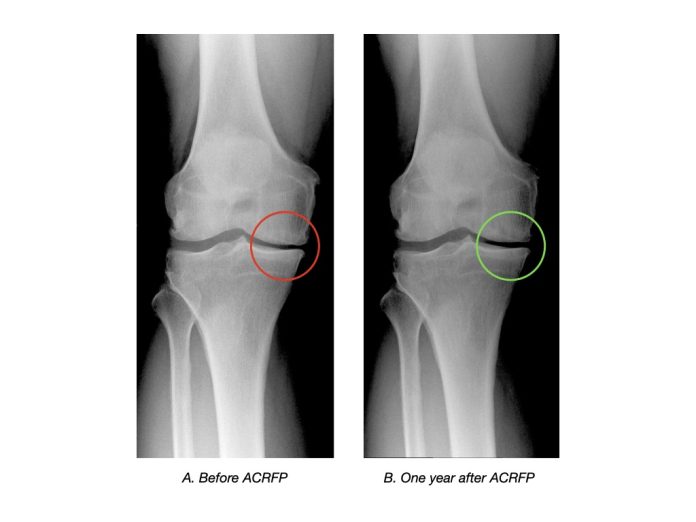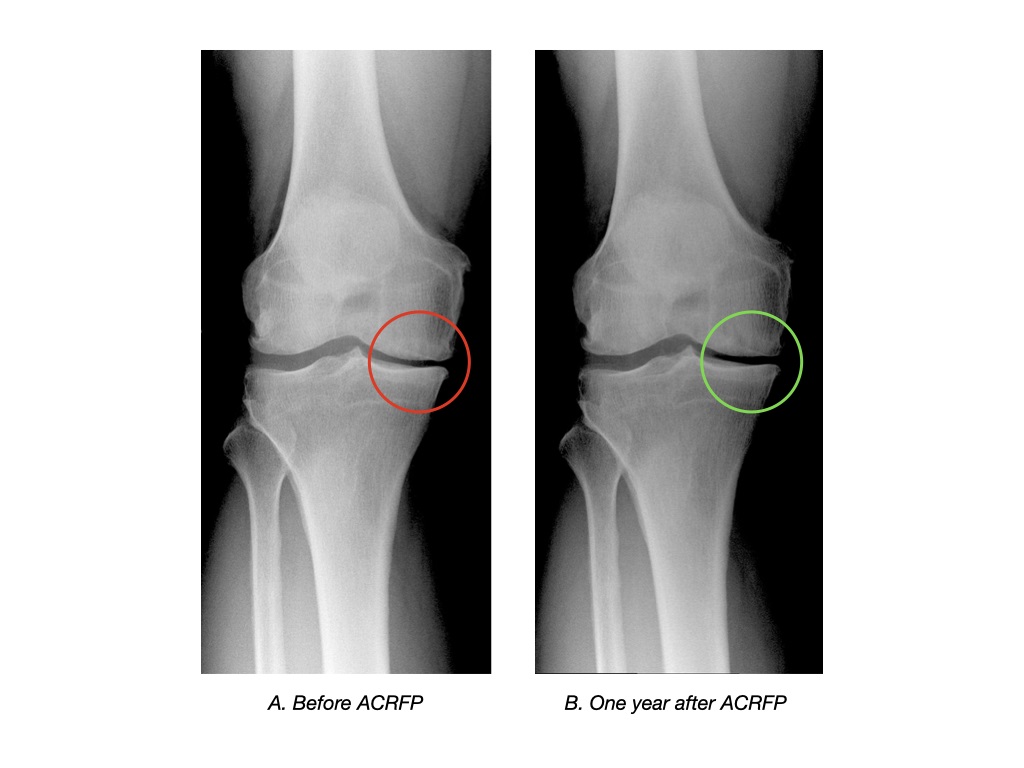Here Open Access Government explore a testimonial from a patient who received a “wonder” therapy for his knee osteoarthritis (OA)
In July 2013, after working for the world’s largest IT company for 30+ years, I thought it was time to start building a healthy lifestyle and losing weight. Therefore, I designed a fitness program that mixes swimming/gym workouts, cycling, walking, and more focus on dieting.
In this program, I demanded I swim 1000 meters in an Olympic swimming pool plus 30 minutes of gym workout, cycling for one hour, or walking 90 minutes every day. At the same time, I carefully monitored my daily food intake. I was able to strictly implement the plan whether I was off work, taking overseas holidays or after I returned to work full-time in the Autumn of 2015.
I joined a bushwalking group in the Summer of 2014. This group mainly walked along trails through Sydney National Parks and Reserves; each bushwalk could last 4-6 hours, including breaks and uphill/downhill walks.
I lost fourteen kg in eighteen months but could not lose more weight with the same exercise routines.
A series of health setbacks
One evening in the summer of 2015, I fell off a bicycle when a child blocked my eyes with his kite line. I had blood all over my face; some of my teeth were almost broken. I had scratches on my legs and arms.
This dreadful fall killed cycling from my fitness agenda.
Following this, I found swimming was not convenient and not straightforward and I needed to drive 15-20 minutes and paid membership to swim at an Aquatic Centre.
All these incidents and issues left walking as the only option to help me continue my slimming program.
From Autumn 2016, I took two bush walks and five 90-minute walks per week. Each bush walk took 3-5 hours and required significant uphill/downhill steps. Even with these heavy exercises, I still could not lose more weight.
In the Summer of 2016, I started to feel knee pain when I bent or straightened my knee. I could not walk far enough or as quickly as I could. I promptly felt aching whenever I walked a bit further or faster. It was too much for me to step up or down the stairs. I needed to take the lifts or escalators to mitigate the pain.
A few bushwalkers gave me recommendations on how to alleviate the pain. None of these recommendations was able to relieve my agony; they did not think my issue was severe. No one would worry that I might have knee osteoarthritis. Everyone thought my troubles would disappear if I let my knees rest more.
Suddenly, I felt panic that I could not do my regular walking exercises and maintain a more active lifestyle.
Dire outlook: Seeking orthopedic help
I still felt discomfort even though I stopped my regular exercise. I walked with a limp whenever I moved. It wasn’t until I had an appointment with a physiotherapist that I had a better picture of my suffering. The therapist diagnosed that my cartilage might have worn away. The cartilage loss narrowed the joint space and caused the bone to rub another bone. At that point, there was little, or no cartilage left to do a job as the shock absorber. He bluntly urged me to see an orthopedic specialist as quickly as possible.
Dr. Charlie Lin, an orthopedic surgeon at Sydney Adventist Hospital, advised me in February 2016 that I needed to have a partial knee replacement surgery to tackle my knee issue. If I hadn’t had this surgery, I would have needed to have a total knee replacement operation five years later. His advice was a significant blow. I had never thought the overwork of my knees could potentially cause such massive damage to my daily life.
Nevertheless, I would not commit to knee replacement surgery until I had tried all options. I sought a second opinion and searched for all studies related to Knee Osteoarthritis. Partial/total knee replacements are the only treatments available in Australia to cure my knee pain. Therefore, I looked for alternatives in my home country, Taiwan.
ACRFP Arthroscopic Cartilage Regeneration Facilitating Procedure: Not just an alternative
Here is a YouTube video from Tzu-Chi DaAi TV. I watched this video several times and found it gave me some fresh ideas. I printed the ACRFP (Arthroscopic Cartilage Regeneration Facilitating Procedure) document, which Dr Lyu wrote, and discussed this new therapy with Dr Lin.
He was not convinced that the procedures mentioned in this document could heal my damaged knees; he also argued that this medical document was not approved or accepted in the Global Health community. He did not encourage me to pursue this option.
Nonetheless, the ACRFP was the only treatment to keep my knees intact. I had no choice but to make an appointment with Dr Lyu. I was astounded to realise he was so popular. Getting the appointment call to go through or having the email forwarded was challenging.
Eventually, we found the right path to make an appointment with Dr. Lyu. I booked a meeting with him in May 2017.
Only through the chats I had with clinical patients on the appointment day did I feel comfortable taking the ACRFP. These patients told me how their lives had changed after taking the ACRFP. From the conversations, I found the confidence they had and the gratitude they could express for the extraordinary services provided by Dr Lyu and his team.
In my appointment with Dr Lyu, he showed me the X-ray of my broken knees and confirmed I had stage 3 of degeneration in my right knee and stage 2 of degeneration in my left knee. He explained how the ACRFP could help me and what self-care exercises I should take before the operation.
On this trip, I reserved December 7 as the day of taking the ACRFP. Dr Lyu and his team suggested I practice three self-care exercises four times daily: Raising the leg, Knee bending, and Knee pressing. They would like to see if these exercises could assuage my knee pain or improve my physical agility.
ACRFP: The front-runner to cure knee Osteoarthritis
In December 2017, I spent two weeks in Taiwan to have the first surgery of my life. I spent seven days in the Buddhist Dalin Tzu Chi General Hospital. The operation only took fifteen minutes. The entire procedure was painless. Dr Lyu explained the progress of the whole surgery, and I could see the development from the monitors next to me.
Besides, I reckoned I had received the best inpatient care and treatment while I was recovering from the operation.
I flew back to Sydney after having had surgery for two weeks and returned to work a week later. Since then, I have followed the ‘Self-Care after ACRFP’ guideline to perform rehabilitation and wound healing. The instruction indicates that the patient, much more than the surgeon, determines the success of the ACRFP. Hence, the daily rehabilitation exercises, such as raising the leg, knee bending, and knee pressing, have become an integral part of my daily practices to reverse knee degeneration.
After recovering from surgery for more than 3-4 months, I took 15 days of holidays in Japan. My wife and I walked one-third of mainland Japan. During this holiday, I could walk about 10-15 km daily and take stairs up or down in the subway stations. Whenever I felt pain or discomfort, I just needed to do a bit of self-massage.
After finishing the holiday, I had Dr Lyu re-examine my knees. He found that the muscles of my knees were immensely strengthened. Therefore, his case manager advised me to put more effort into raising the leg.
By and large, my knees gradually feel more and more comfortable. I could walk a longer distance and up and down stairs with/without holding the handrail. I felt relieved that I could resume my beloved walking exercise, such as walking 10000+ steps daily. When I finished the office work and returned home, I would walk an additional 5000-7000 steps in the oval near my home to reach my target. I stopped taking lifts in the train stations; instead, I would walk up and down stairs. At the same time, I continued to do daily self-care exercises when I sat on the train or took morning and afternoon breaks.
I took my second holiday in Prague, the Czech Republic; Munich, Germany; Salzburg, Austria; and Switzerland in September. I felt more relaxed and could freely walk and travel from one place to another. I walked uphill for 45 minutes to reach the “Sleeping Beauty” Neuschwanstein Castle and walked faster than most tourists. I was so excited that I regained my walking speed and agility after taking the ACRFP for nine months.
I returned to Dalin Tzu Chi for an annual knee check-up in December. Dr Lyu verified that the joint space of my right knee had reopened, and the degenerative process had ceased (Figures A and B). This was great news after suffering knee pains for such an extended period. Dr Lyu and his case manager also advised me that I could do any regular activity, but not heavy duties, from then on.
Reflection and appreciation
Reflecting on what I have been through, I am convinced that I made the right decision in my journey to restore healthy knees. Dr Lyu’s patients gave me the courage and determination to decide on this overseas therapy. In my latest revisit with Dr Lyu in April 2023, my knee cartilage looks promising to regenerate. I am so pleased that my knee joints are intact, and I have regained an active lifestyle. I have resumed most fitness activities I enjoyed before I had knee damage.
Perhaps I can’t be as speedy and agile as before, partly because I have turned 68. But I have regained freedom of movement, mobility rights, travel rights, progressive thinking, and the ability to explore happiness. These rewards justify the cost and effort to solicit innovative treatment from a medical master like Dr Lyu.
If you are also on the journey to return to an active and happy life, I welcome any questions you may have.
Albert Chung
albert4chung@gmail.com
What is ACRFP?
The ACRFP (arthroscopic cartilage regeneration facilitating procedure) is an integrated, comprehensive, and novel arthroscopic surgery that aims to remove all existing risk factors of knee OA from the knee, hence eliminating knee pains and making the knee a more hospitable place for the cartilage inside to regenerate.(1-3) The ACRFP (1) eradicates the medial abrasion phenomenon and inflamed synovium and capsule, (2) decompresses the patello-femoral joint, (3) restores soft tissue balance around the patella, (4) removes other known risk factors (synovitis, meniscus tears and chondral flaps) of knee OA, and (5) consequently improves the environment in the knee to be more hospitable to cartilage regeneration. Therefore, knee OA patients who receive ACRFP are much more likely to avoid knee replacement.
References
- Lyu SR, Hsu CC, Lin CW. Arthroscopic cartilage regeneration facilitating procedure for osteoarthritic knee. BMC Musculoskelet Disord. 2012 Nov 21;13:226. doi: 10.1186/1471-2474-13-226. PMID: 23171074; PMCID: PMC3583133.
- Lyu SR, Hsu CC, Hung JP, Chou LC, Chen YR, Lin CW. Arthroscopic cartilage regeneration facilitating procedure: A decompressing arthroplasty for knee osteoarthritis. Medicine (Baltimore). 2022 Sep 30;101(39):e30895. doi: https://doi.org/10.1097/MD.0000000000030895. PMID: 36181017; PMCID: PMC9524980.
- Lyu SR, Hsu CC, Hung JP, Chou LC. Arthroscopic cartilage regeneration facilitating procedure can modify the clinical course of knee osteoarthritis. J Orthop Surg (Hong Kong). 2023 May-Aug;31(2):10225536231180331. doi: https://doi.org/10.1177/10225536231180331. PMID: 37395209.









